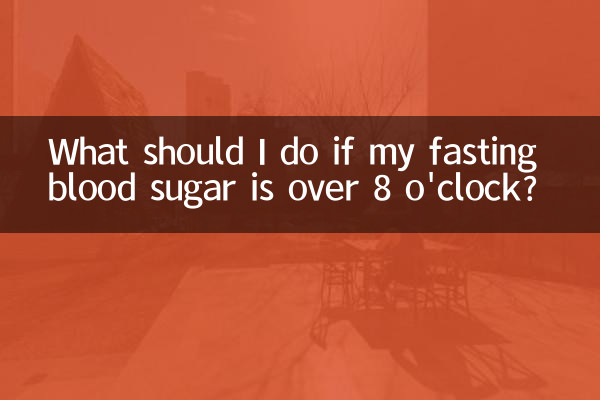What should I do if my fasting blood sugar is over 8 o'clock? ——Comprehensive analysis and response strategies
Fasting blood glucose is one of the important indicators for the diagnosis and management of diabetes. If your fasting blood sugar value reaches above 8.0mmol/L, it may indicate poor blood sugar control or the risk of diabetes. This article will combine the hot health topics on the Internet in the past 10 days to provide you with structured data analysis and practical suggestions.
1. The clinical significance of fasting blood glucose 8.0mmol/L

| Blood sugar range (mmol/L) | clinical significance |
|---|---|
| 3.9-6.1 | normal range |
| 6.1-7.0 | Impaired fasting blood glucose |
| ≥7.0 | Diabetes diagnostic criteria |
| 8.0+ (duplicate detection) | Requires immediate medical intervention |
2. Top 5 recent popular sugar control methods (data source: health topics across the Internet)
| Ranking | method | Discussion popularity | evidence of effectiveness |
|---|---|---|---|
| 1 | 16:8 Light fasting | ★★★★★ | Multiple studies show improved insulin sensitivity |
| 2 | low carb diet | ★★★★☆ | Significantly lower blood sugar in the short term, professional guidance is required |
| 3 | Post-meal exercise method | ★★★☆☆ | A brisk walk 30 minutes after a meal is most effective |
| 4 | dietary fiber supplement | ★★★☆☆ | 25-30g per day can delay sugar absorption |
| 5 | sleep optimization | ★★☆☆☆ | Lack of sleep significantly increases fasting blood sugar |
3. Three steps for emergency treatment
1.Confirm detection accuracy: Excluding the influence of factors such as eating and stress state 8 hours before the test, it is recommended to monitor continuously for 3 days.
2.Instant diet adjustments: Immediately stop the intake of high GI foods and recommend an emergency diet combination:
| food category | Recommended choice | Taboo |
|---|---|---|
| staple food | 50g oatmeal | White porridge/white bread |
| protein | 2 boiled eggs | Fried |
| vegetables | Cold bitter melon 200g | starchy vegetables |
3.24 hour action list:
• Morning: Complete glycosylated hemoglobin test (HbA1c)
• Afternoon: 30 minutes of moderate intensity exercise
• Evening: Record the food and blood sugar fluctuations throughout the day
4. Long-term management plan
According to the recent expert consensus in tertiary hospitals, the following comprehensive management framework is recommended:
| management dimension | specific measures | target value |
|---|---|---|
| Monitoring frequency | Fasting + 2 hours blood sugar after three meals | At least 2 days a week |
| nutritional intervention | Carbohydrate 50-55% energy supply ratio | GI value≤55 |
| Exercise prescription | Combined aerobic + resistance | 150 minutes per week |
| drug evaluation | Metformin-based medication | Make adjustments as directed by your doctor |
5. Latest research progress (updated in 2023)
1. Intestinal flora regulation: Specific probiotic strains (such as L.reuteri) show auxiliary hypoglycemic effects
2. Chrononutrition: Consuming 50% of the day’s calories at breakfast can help stabilize blood sugar throughout the day.
3. Digital therapy: The error rate of the AI blood glucose prediction system has dropped to less than 8%
Important reminder:If fasting blood glucose continues to exceed 7.0mmol/L, timely medical treatment is required. The recommendations in this article cannot replace professional diagnosis and treatment. It is recommended to collect this guide and share it with those who need it. Regular monitoring is the cornerstone of diabetes management.

check the details

check the details